Mumbai, the city of dreams. Although, it might not be the capital of India, it certainly holds a strategic importance and continues to be the financial hub of the country and provides employments to countless people across the country who come here with dreams to make it big. It is the city of money, power, greed, crime and love. However, Bombay as it was known then was quite different from what it has become now. This time I am taking you back in time to explore a different shade of the city which is now known as the Maximum City. I am fascinated by the heritage structure of South Mumbai (maybe because I grew up watching these buildings,fountains, structures all my life) and so I want to take my readers on a South Bombay (now Mumbai) tour, especially my friends and readers abroad who know very little about my city.
Let me inform my readers that on this tour, you might have to scroll up and down to double check the images because as I keep explaining things you will need to refer the pictures, a sort of virtual photographic tour.
Let’s begin our virtual ride with a place called Banganga Tank located in Walkeshwar.
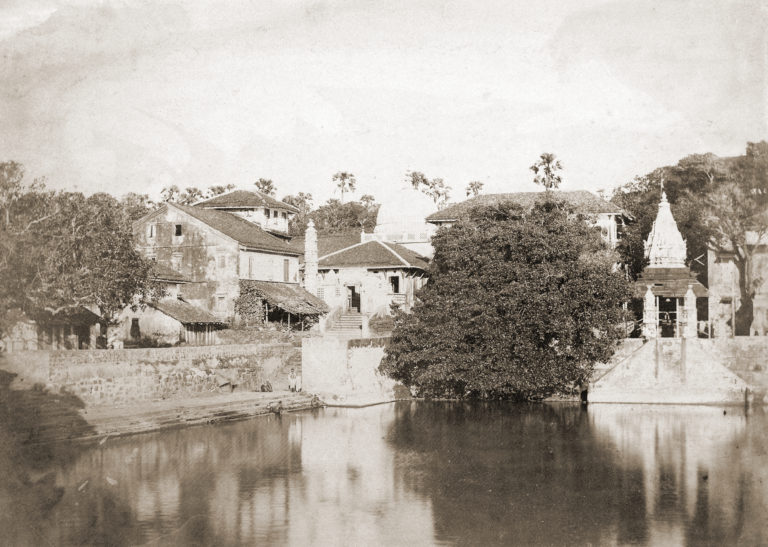
Banganga Tank – Walkeshwar (1855)
Not sure how many city residents know about this one, because this secluded water tank still exist in the cozy corner of the city. Located in the posh locality of the Malabar Hill, Banganga Tank is a part of Walkeshwar Temple Complex and was built in 1127 A.D. by Lakshman Prabhu, a minister in the court of Silhara dynasty during the reign of Chittaraja. The temple was destroyed when Portuguese invaded Bombay Islands, but was rebuilt on the same place in 1711 and the construction was completed by 1715. Banganga is a rectangular pool structure which also has a Hindu cremation ground nearby. The most interesting thing about this tank is that the water is sweet, despite its location which is just few meters away from the Arabian Sea. In the image above, you can see the Walkeshwar Temple on the right side, while the image below you can two entrance pillars that provided space for oil lamps during night time. Anyone interested in why its called ‘Banganga’ can comment below and I will explain the story behind its name.
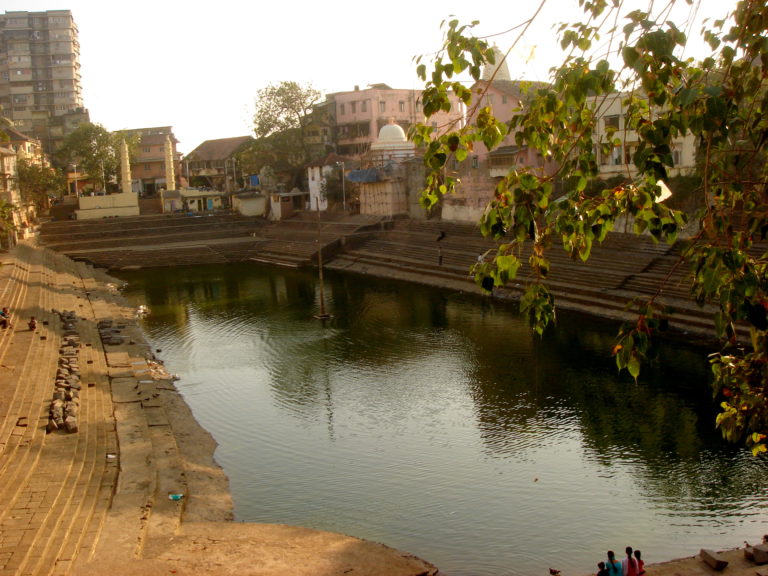
Banganga Tank – Walkeshwar (2010)
Now, we move further south towards Crawford Market which remains one of the biggest markets in the city.
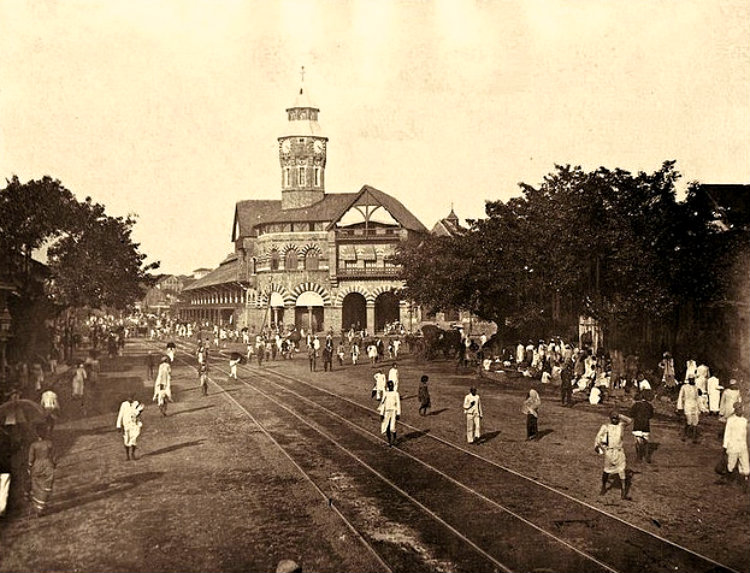
Crawford Market – Mumbai
Well, I am not sure about the year in which the image above was taken, but since it has railway tracks I can guess it is only after 1857. Today, this same area remains choc-a-block on weekends and every evening. Interestingly, Crawford Market was earlier known as Arthur Market, named after Arthur Crawford, first Municipal Commissioner of Bombay. The building in the image was built by donation provided by Cowasji Jehangir, a prominent member of the Bombay Parsi community. The market was designed by British architect William Emerson and the construction was completed in 1869. It was the first building in India to be lit up by electricity in 1882. However, after Independence, the market was renamed as Mahatma Jyotirao Phule Market to honor Maharashtrian social reformer for his struggle for India’s independence. Surprisingly, the old name stayed and locals still know it as Crawford Market.
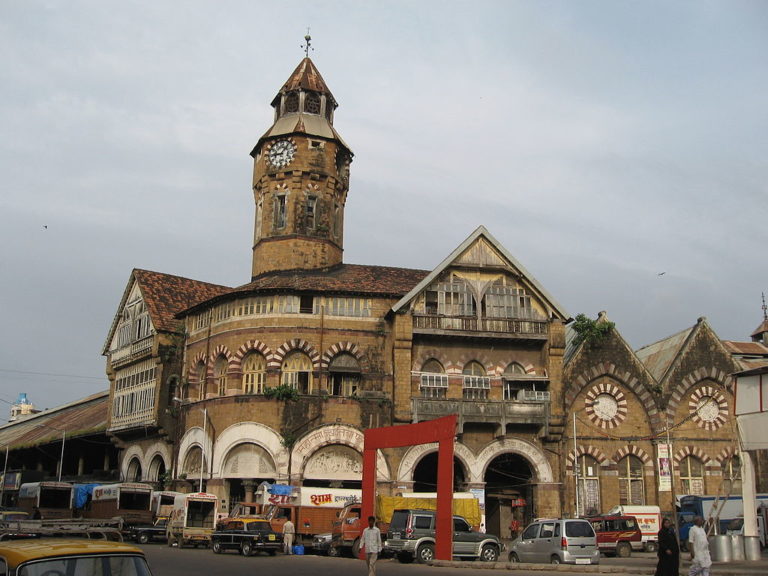
Crawford Market – Mumbai
As we walk further south we come across one of the most magnificent buildings in the city. The Victoria Terminus station and right opposite to it is the Bombay Municipal Corporation Headquarters. In the image below, the road that cuts between these two buildings leads to Crawford Market which is just 5-7 minutes walk.
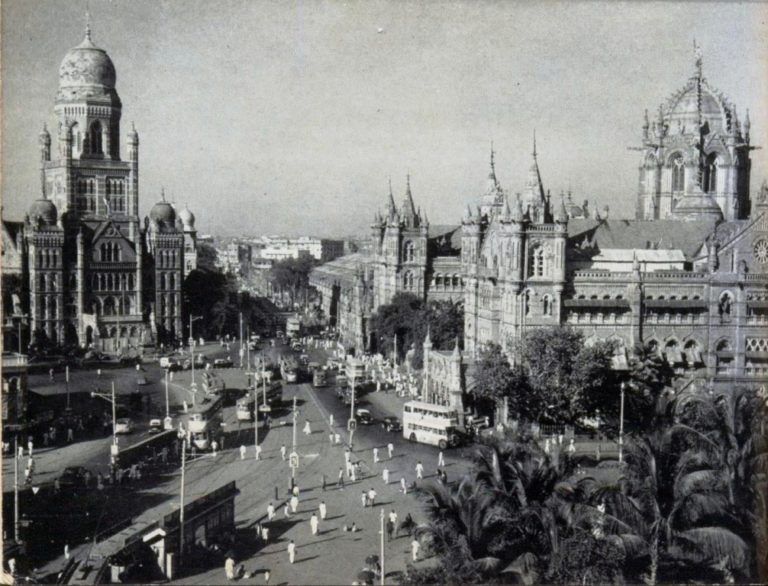
Victoria Terminus (right) and Municipal Corporation HQ (left)
Victoria Terminus now known as Chhatrapati Shivaji Terminus is a UNESCO Heritage site and headquarters of the Central Railway and the biggest and the busiest railway station in the country. It serves as a terminal for both local trains and long distance trains from all over India. Designed by Frederick William Stevens, both the iconic structures have influences from Victorian Italianate Gothic Revival architecture. The construction began in 1878 and completed in 1888 making it the most complex and longest to complete project in the city in its era. The station has 18 platforms, 7 for commuter trains and 11 for long distance trains.
Right opposite is the Municipal Corporation Building that houses civic body that governs the city. The BMC (Bombay Municipal Corporation) was created in 1865 and Arthur Crawford (after whom Crawford Market is named) became its first Municipal Commissioner. The building construction began in 1884 and was completed in 1893.
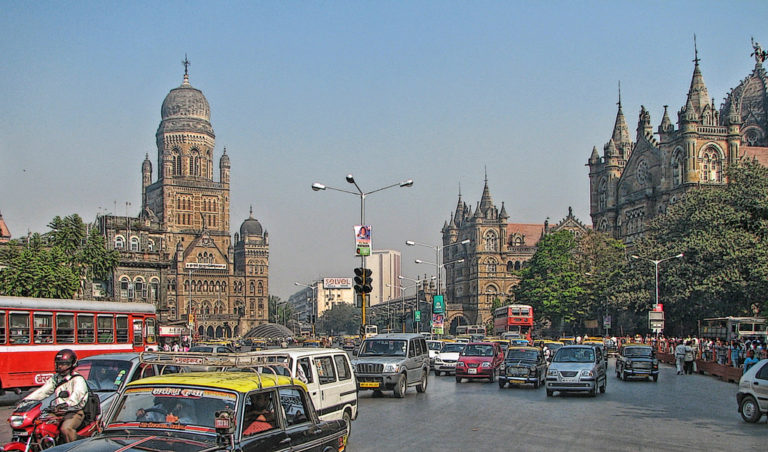
Victoria Terminus and Municipal Corporate HQ
Okay, we continue our journey southwards and we move in the direction of the traffic as seen in the above image (currently we are at the north end of the D.N. Road) and right after two blocks we arrive at the Flora Fountain.
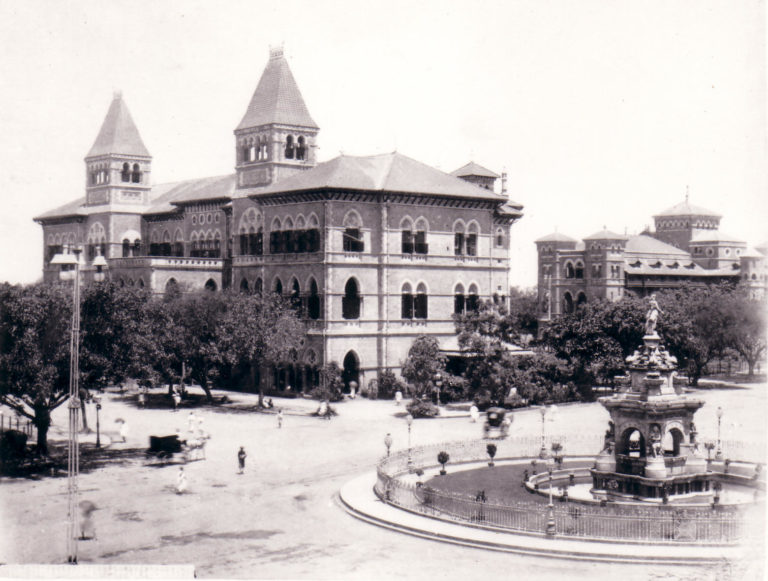
Flora Fountain – Mumbai
This architectural heritage monument stands on the southern end of the D.N. Road. It lies at the heart of the Fort business district, so one may call it ‘The Times Square of South Bombay‘. Built in 1864, the fountain depicts the Roman goddess Flora. Built at a cost of 9000 pounds (a hefty amount then), this fountain still attracts lot of visitors and tourists from all over India and the globe (although maintained poorly by the authorities). For more images of Flora Fountain click here.
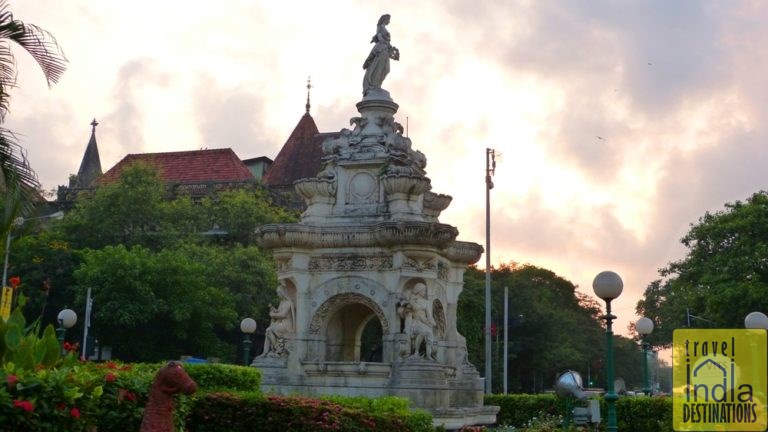
Flora Fountain – Mumbai
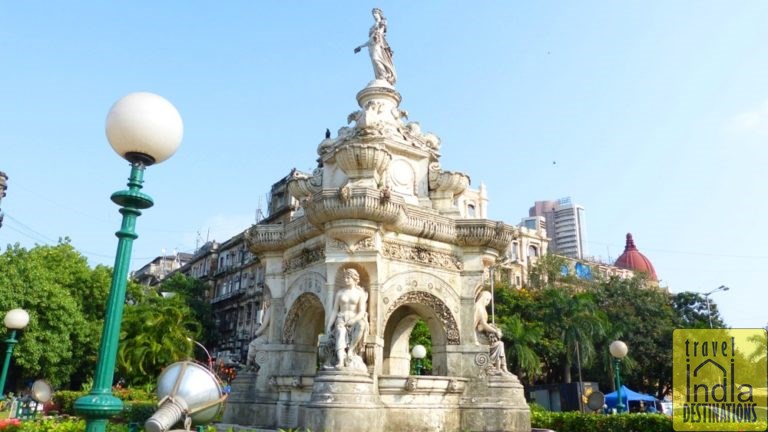
Flora Fountain (East Side)
Now, please refer image tagged as Flora Fountain (East Side) (right above), do we cluster of trees on the left side of the picture? Well, if we take that boulevard, we reach Horniman Circle Gardens, our next destination.
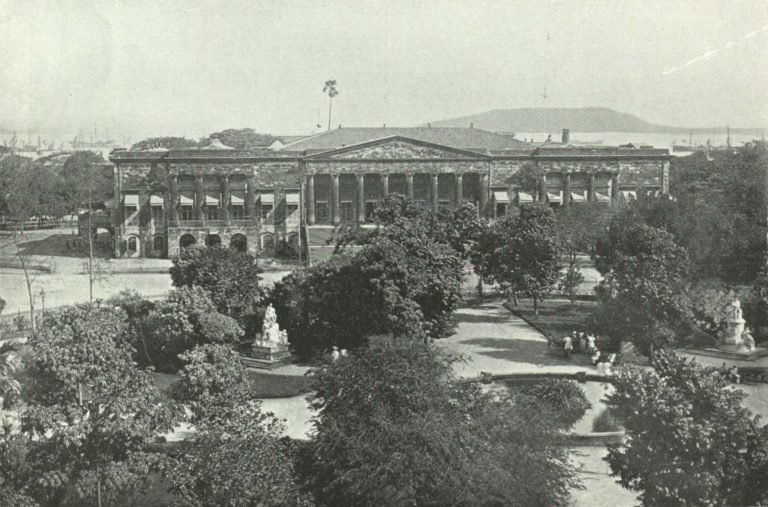
Horniman Circle Gardens with Asiatic Society of Bombay
Not too far from the Flora Fountain is Horniman Circle Gardens located in the Fort business district surrounded by offices complexes usually acquired by premier banks and financial institutions. Not too far from it is the Bombay Stock Exchange building, so in some sense this area is the ‘Wall Street of South Bombay‘. Initially, the area was known as Bombay Green and this circular open garden was called ‘Elphinstone Circle’. The garden was planned in 1869 and was initially just a dumping place. Charles Forjett, Commissioner of Police decided to convert the space into a garden and the garden was completed in next three years along with walkways and trees planted well around it. The idea was then supported by Governor Lord Elphinstone and so the whole garden complex was initially named after him. The garden also has a modern art deco ornamental fountain made from iron pipes. However, after India’s independence in 1947, the garden was renamed in honor of Benjamin Horniman, editor of the Bombay Chronicle newspaper who also supported India’s freedom movement.
Below is the image of the Asiatic Library from inside of Horniman Circle Gardens. One can also see the Reserve Bank of India Headquarters tower from between the trees (towards left).
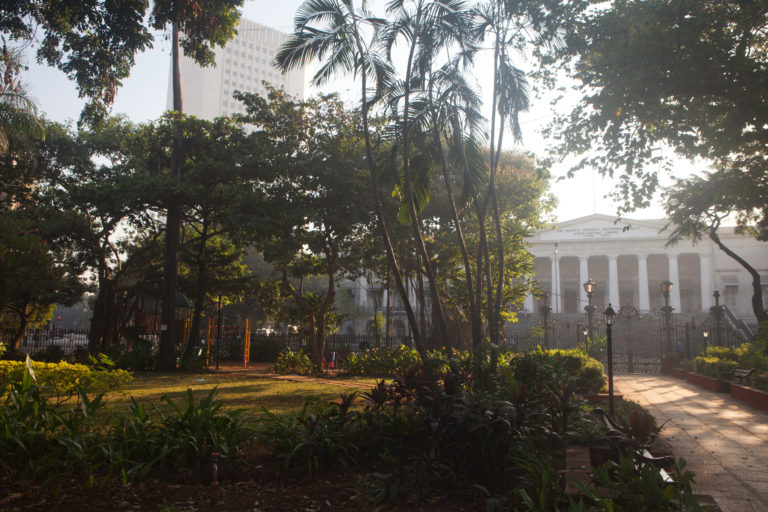
A View of Asiatic Library from Horniman Circle Garden
So, now we’ve arrived at our next heritage structure called The Asiatic Society of Mumbai right next to the Horniman Circle Gardens.
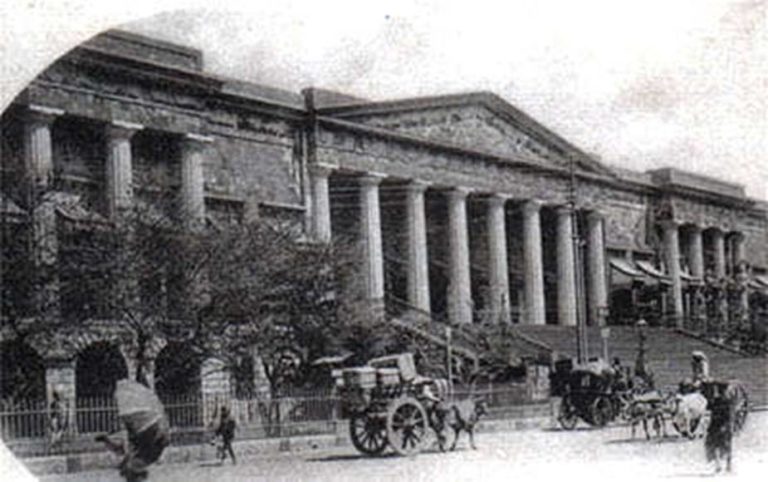
Asiatic Library Mumbai
Well, today we call it as The Asiatic Library, but in its glory days it was more popularly known as The Asiatic Society of Bombay established in 1804 founded by Sir James Mackintosh, Chief Judge of Bombay then. The intention of this learned society was to promote useful knowledge connected with India. It got affiliated with Royal Asiatic Society of Great Britain and Ireland in 1823 and later on The Bombay Geographical Society merged with it in 1873, followed by the Anthropological Society of Bombay in 1896. After India’s independence, the society parted ways with the Royal Asiatic Society and renamed itself as the Asiatic Society on Bombay funded by the annual grant from the Central Government of India. The library of the society holds innumerable books, manuscripts, coins and maps of which 15,000 are classified as rare and valuable. It also stores one of the only two known original copies of Dante’s Divine Comedy. In 1930, the Italian government under Mussolini offered the society one million pounds to acquire the original copies, but to his shock the society turned down his request.
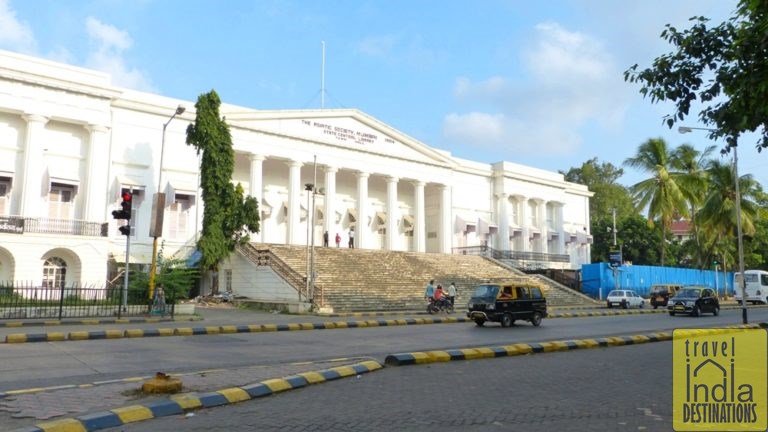
Asiatic Library – Mumbai (2015)
Okay, now we head in the opposite direction of those cabs in the above image and head to Elphinstone College.
Well, let me tell you I’m a proud student of ‘Elphi’ (that’s what we call it) and I believe it is one of the best colleges in Mumbai for students who want to pursue Arts. In the image below, we see Elphinstone College with David Sassoon Library right next to it. We also see a black stone statue right in the middle of the road. Well, that’s the statue of King Edward VII also known as the Prince of Wales. It is because of this black horse statue that the area is named today as ‘Kala Ghoda‘ which literally means ‘Black Horse’. The statue was shifted from this position in 1956 and that particular area is now a paid parking lot.
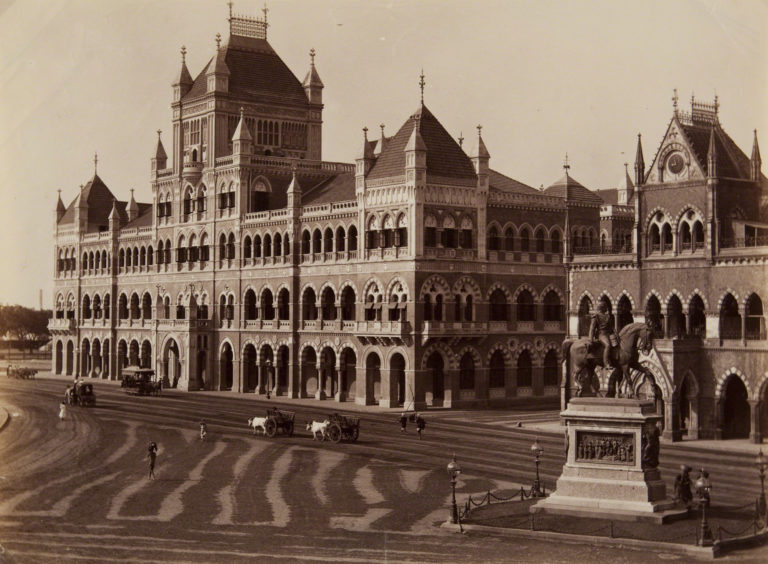
Elphinstone College (left) & David Sassoon Library (right)
Affiliated to the University of Mumbai, Elphinstone College was founded in 1856 making it the oldest colleges of the University of Mumbai. The college played an instrumental role in spreading Western education during the British rule. It is a Grade I Heritage structure renowned for its Romanesque Transitional architecture. Named after Hon.Mountstuart Elphinstone, Governor of Bombay, the college was initially known as ‘Elphinstone Native Education Institution‘, but was later shortened to Elphinstone Institution and eventually named as Elphinstone College. While its standards have declined in the recent times due to red tapism and negligence by the government, but in its time the college was looked upon as a prestigious seat of learning and popular for its vibrant alumni including freedom fighters and visionaries like Bal Gangadhar Tilak, Bhim Rao Ambedkar (principal architect of the Constitution of India), Badruddin Tyabji, Jamshetji Tata (founder of Tata Group), Dr. Homi Bhabha (nuclear physicist), P.N. Bhagwati (Chief Justice of India), C.D. Deshmukh (former Finance Minister of India), and Iskander Ali Mirza (first President of Pakistan).
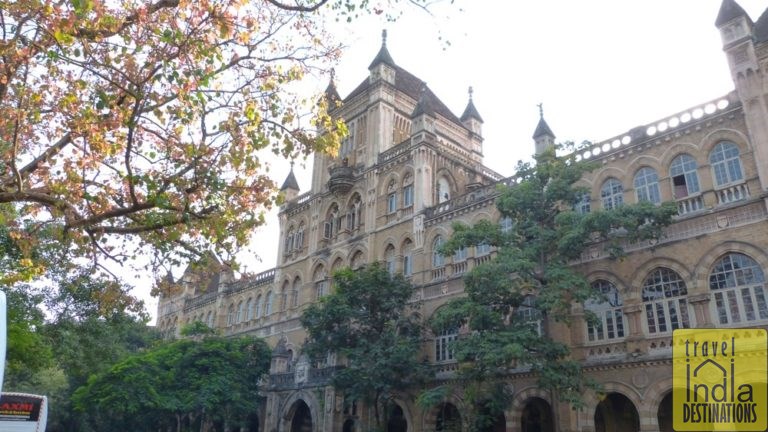
Elphinstone College Mumbai
Built by Albert Sassoon and designed by J. Campbell and G.E. Gosling for the Scott McClelland & Company, David Sassoon Library was completed in 1870.
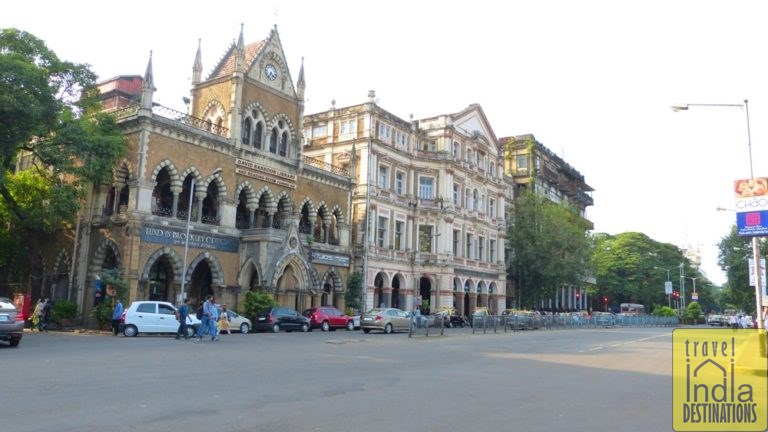
David Sassoon Library – Mumbai
In the above image, we see David Sassoon Library, next to it is Army & Navy Building and the not-so-well-maintained Watson Hotel. Right after the Watson Hotel, we see cluster of trees which brings us to the University of Mumbai.
In this image below we see the University of Mumbai, Rajabai Clock Tower and The Oval right behind those buildings (you’ll learn about it soon).
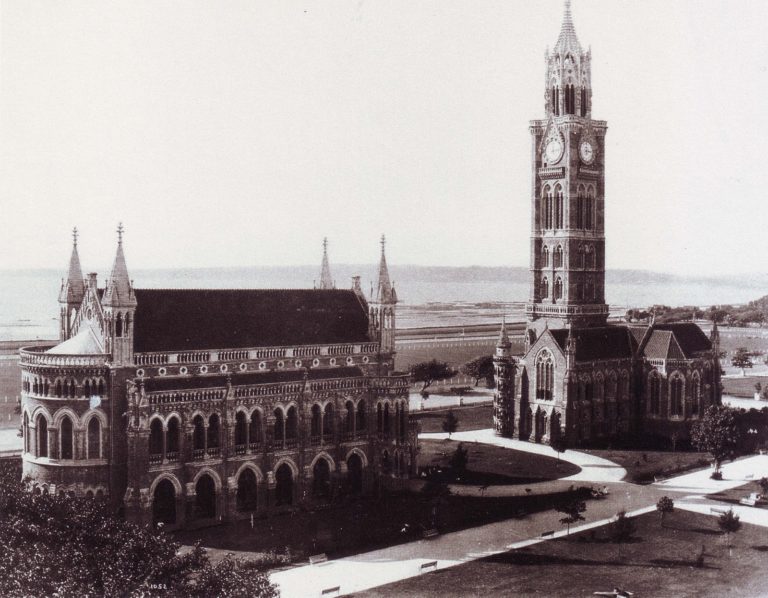
Mumbai University (Left) with Rajabai Clock Tower (right)
One of the oldest universities in India and Maharashtra, the University of Mumbai offers Bachelors, Masters and Doctoral degrees along with diplomas and certificates in many disciplines. It is considered to be one of the largest universities in the world in terms of student enrollment. In 2011, University of Mumbai enrolled 549,432 students and is currently affiliated with 711 colleges making it the fifth largest public university in India. Notable alumni of University of Mumbai are Muhammad Ali Jinnah, Mahatma Gandhi, Bhim Rao Ambedkar, Homi Bhabha, Jamshetji Tata, Sunil Gavaskar, Dadasaheb Phalke, Homai Vyarawalla, Mukesh Ambani, Anil Ambani, Chanda Kochhar, Nissim Ezekiel, Raghavan Narasimhan, and many others. Some exclusive exterior shots of the University of Mumbai. Click here.
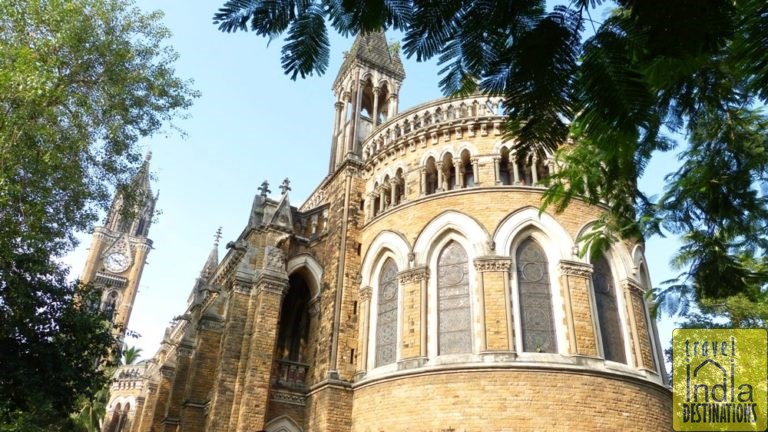
Exterior of Mumbai University with Clock Tower in the Background
In the confines of the campus of the University of Mumbai stands the Rajabai Clock Tower which once was the tallest building in the city. Designed by Sir George Gilbert Scott, the clock tower takes inspiration from the Big Ben in London. The construction began in 1869 and was completed by 1878. The cost of the construction was beared by Premchand Roychand, a prosperous broker and founder of the Bombay Stock Exchange and was renamed after his mother Rajabai. As per the records, Roychand’s mother was blind, but religiously followed her routine which included eating dinner before evening. Roychand built the clock tower so his mother can know the exact time of the day independently with the help of the evening bell. The tower fuses Venetian and Gothic architecture style and incorporates the best stained glass windows found in the city. During the British rule, it played ‘Rule Britannia’, ‘God Save the King’, ‘Home Sweet Home’ and ‘A Handel Symphony’ along with 16 other tunes which changed four times a day.
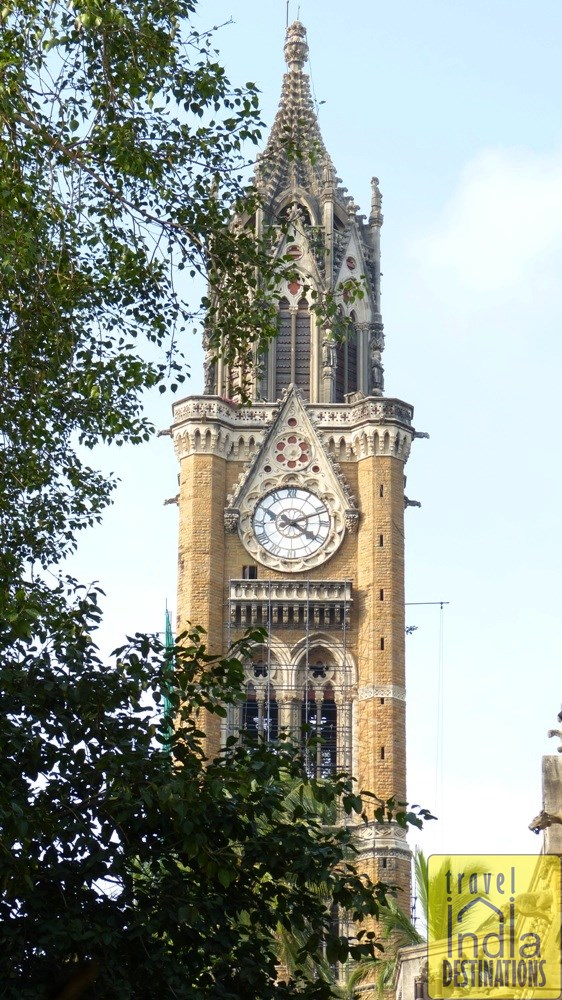
Rajabai Clock Tower Fort Mumbai
Well, not too far from the Rajabai Clock Tower is The Oval. Below is the image of The Oval (1875).
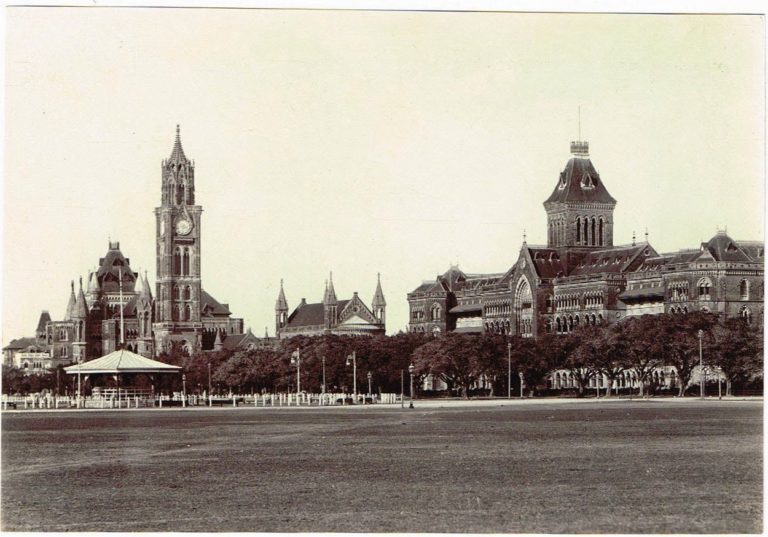
L to R – Mumbai High Court, Rajabai Clock Tower, Mumbai University and Sessions Court
The Oval, it is a large rectangular-shaped Grade I recreational ground where you see people playing cricket and football most hours of the day. If you visit this ground on Sundays, you’ll find over 100 cricket teams of local boys and men playing cricket. It will be hard for you to understand who is fielding for which team and if you’re fielding you got to watchout for balls that can zip pass your face, arms and legs and sometimes strike you unknowingly. Sounds funny and scary, but its true. The ground is not permitted for hosting any political or religious functions or mass gatherings. In the below image, (watch keenly), its easy to spot the Rajabai Clock Tower, on the right side of it is the University of Mumbai (I guess only the roof is visible), the building on the extreme right is the Sessions Court. On the left side of the clock tower we see a dark Gothic structure which is the Mumbai High Court. On the far end of the ground if you notice the pitch is greener, that’s because that space is owned by a cricket academy that provides training to budding professional cricketers. (You may right click on the below image and open it in a new tab to see full size image)
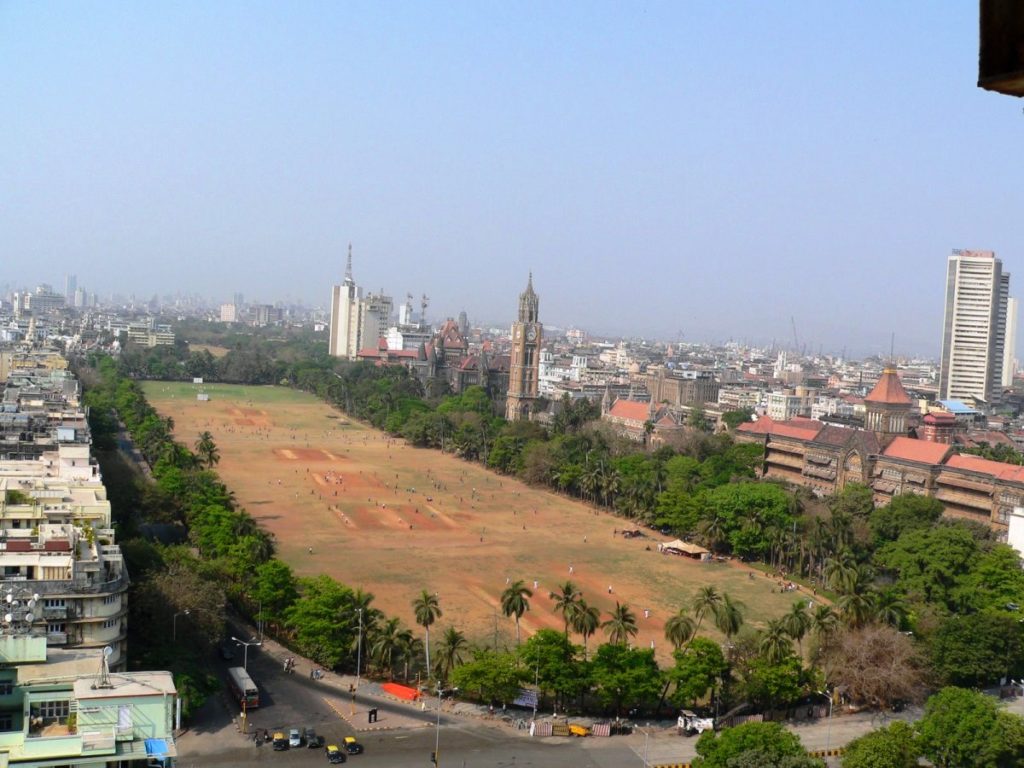
Oval Maidan – A Better View
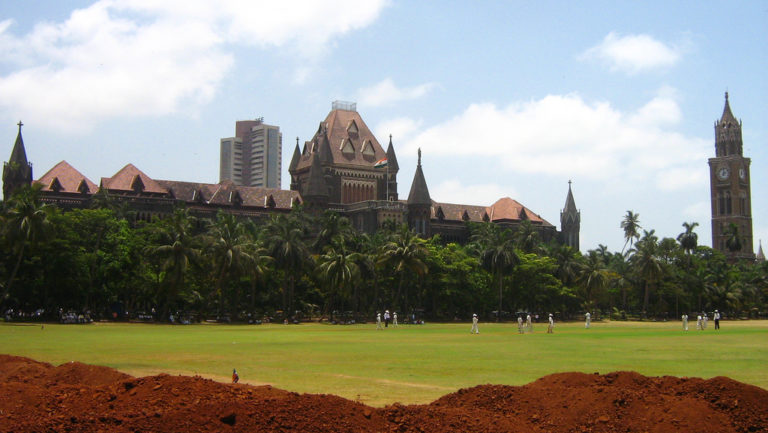
Mumbai High Court from the Cricket Academy Pitch Area
Standing at the north end of The Oval, if you turn around you see the below heritage structure our final stop, the Western Railway HQ Building.
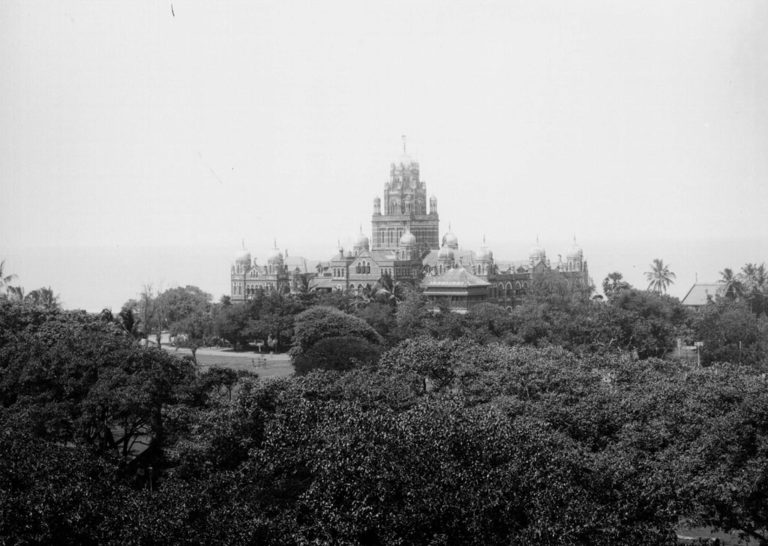
Western Railways Building Mumbai
Built in Indo-Saracenic style, the Western Railway HQ building originally known as the BB&CI (Bombay Baroda & Central India Railways) was completed in 1899. Designed by Frederick William Stevens, the same architect who designed the famous Victoria Terminus.
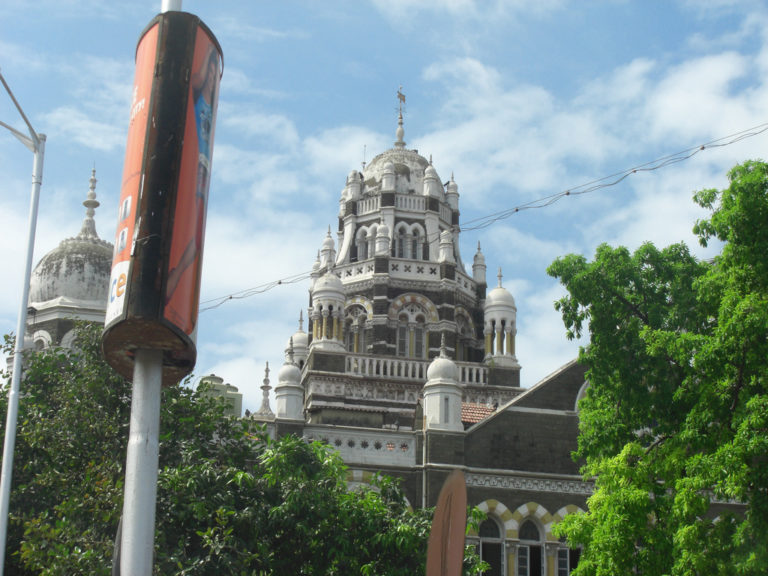
Railways Building – Churchgate
So, here we end our tour of South Bombay. Hope you enjoyed it, as much as I did explaining the details, collecting the images and taking time to write it all down for you. Do let me know your views and any queries you have about South Bombay and I will try my best to answer them in the comment section below.
Thank you.
22 comments
This had been a fascinating tour Sharukh. I love the mix of old and new pictures as well as the history. I am always interested in the history and amazed when you mention dates that are hundreds of years before English settlers landed on the shore of our country. Also, I do want to know the origin of the name Banganga – who wouldn’t?
Well, as per mythology stories Lord Rama and his younger brother Lakshman were on their way to find Sita (Lord Rama’s wife) who was kidnapped by the evil Ravana. When Lord Rama asked his brother to fetch some water, he quickly shot an arrow on the ground and the water emerged. It is believed that the water of this well comes from one of the tributaries of the Ganges a.k.a. Ganga. The word ‘Ban’ means ‘arrow’ so Banganga actually means Ganges which emerged from an arrow. That’s the story behind its name.
Now that’s a great mythology story.
Not sure how much of that is true, but the tank is right next to the sea and it still has sweet water which they say emerges from a spring beneath. I went here with my mother because its hard to find this tank.
That’s very cool. Thank you!
So much rich history Sharukh. And as always you describe it so well, with enough details yo inform without overwhelming me. The photos are my favorite part; and it is quite astonishing to see that not a lot has changed abput the city arxhtecturally speaking. I love the preservation factor of I ian culture. Ditto on Banganga. What’s up with that?
Thank you Cheryl. It took me time to gather the images. I have been working on this since October in bits and pieces.
It’s funny hearing the water hold referred to as a “tank”. The only other place I have lived where water ho,ding areas are called tanks was in the hill country of Texas. Everywhere they are ponds or spring fed lakes. Great story!
Fascinating and beautiful~
Thanks Cindy. I just added a story in the comment section replying to Dan, do read that as well.
I love, love the post, history about Bombay and SoBo never cease to fascinate me. It was the best days of life when i stayed there and can you imagine it was such a regular sight every day. The happier days of life where I studied at Rajabhai library. Mumbai rocks. Glad to go into flash back moments, a Bombay I never knew. I wish to come back, someday and live in the great city. Superb pictures:)
Yeah, I miss that old style Bombay with heritage buildings, but sadly now all that we see is these tall giant buildings coming up in the sake of development which for me symbolizes the ever growing greed and hunger of the people ruining the charm of the city. So where did you lived in Bombay? You have shifted to suburbs or to a new city? If I may ask.
Of course, you can. The family is based in Mauritius and there are plans to be back to Mumbai, which is home to the heart, in a couple of years. I agree selfishness and greed, characterized by builders violating FSI is taking a toll on Mumbai. I stayed at Churchgate, opposite Marine Drive.
Hey nominated you for Liebster:
https://vishalbheeroo.wordpress.com/2015/12/08/i-am-a-liebster-munch-popcorn-and-enjoy/
So glad of you to share. Makes me feel it has been ages since the old ones were erected 🙂
Wow, such a great look at the beautiful past of Mumbai ~ a beautiful way to bring in the New Year ~ great series of photos and tremendous writing. Cheers to a great 2016.
Thank you. I appreciate you taking time to read it and loving it. Hope you’ll love the other posts as well on different Indian cities and destinations. Happy New Year 2016 to you.
🙂 Will definitely check out the other posts, wish you all well!
Such a nice representation of the transition a city does through. History, the names and those sepia images show an era gone by. What a lovely post and great writing you got there.
I wish I could transport myself in those times
A beautiful informative and engaging read. The hard work in research definitely shows up in the article.
Thanks for visiting and commenting, Preeti.